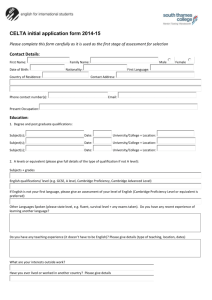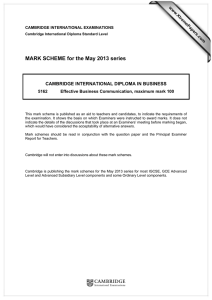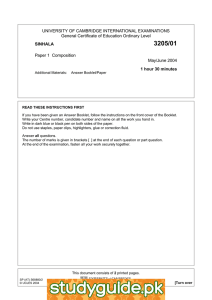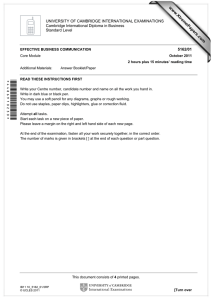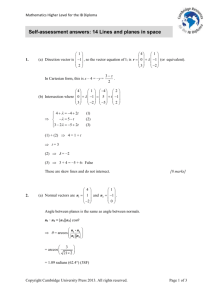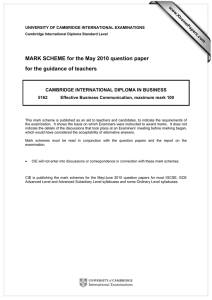MARK SCHEME for the October 2011 question paper
advertisement
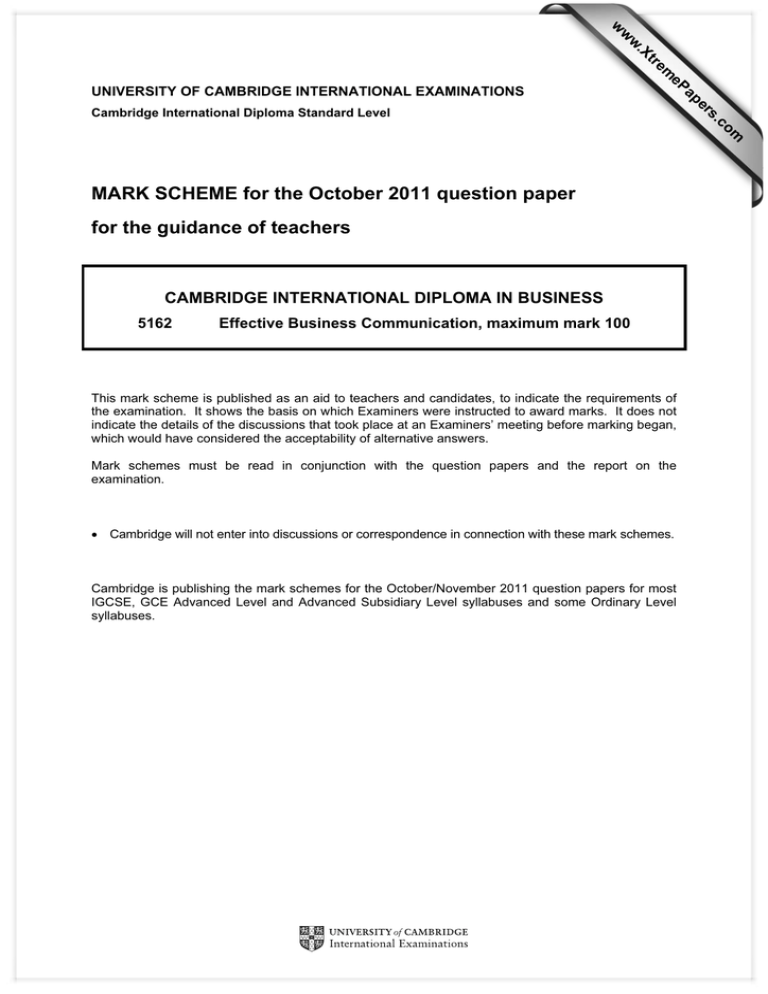
w w ap eP m e tr .X w UNIVERSITY OF CAMBRIDGE INTERNATIONAL EXAMINATIONS om .c s er Cambridge International Diploma Standard Level MARK SCHEME for the October 2011 question paper for the guidance of teachers CAMBRIDGE INTERNATIONAL DIPLOMA IN BUSINESS 5162 Effective Business Communication, maximum mark 100 This mark scheme is published as an aid to teachers and candidates, to indicate the requirements of the examination. It shows the basis on which Examiners were instructed to award marks. It does not indicate the details of the discussions that took place at an Examiners’ meeting before marking began, which would have considered the acceptability of alternative answers. Mark schemes must be read in conjunction with the question papers and the report on the examination. • Cambridge will not enter into discussions or correspondence in connection with these mark schemes. Cambridge is publishing the mark schemes for the October/November 2011 question papers for most IGCSE, GCE Advanced Level and Advanced Subsidiary Level syllabuses and some Ordinary Level syllabuses. Page 2 1 Mark Scheme: Teachers’ version Cambridge International Diploma – October 2011 Syllabus 5162 Ben Chima is very aware of the importance of communication both internally and externally. (a) Explain four reasons why it is important for TFC to communicate with its key stakeholders. [4 x 3 = 12] Communication is necessary for a business to operate successfully Business needs to convey clear messages both within the organisation and to the outside business world – to promote their Fairtrade policy Business needs to receive and process information effectively. Need information from the sales force and their production teams on the level of sales and production targets. To be able to respond to customer feedback and answer any concerns that the stakeholders may have regarding the website and product purchases. To understand any demands for new products or changes in existing products Allow suppliers as a stakeholder (b) Explain four reasons why it is important for TFC to use two-way communication during the implementation of the intranet. [4 x 2 = 8] Candidates should outline four points from the following: To enable an exchange of ideas To receive feedback on communications To motivate all stakeholders to support the introduction of the intranet To respond to the concerns of any staff member regarding training To respond to questions relating to the installation of the intranet [Total: 20] 2 Ben has decided that a meeting of the sales representatives should take place to explain and train them on the introduction of the intranet. The venue will be in Nairobi on the 12th of next month. (a) Write a letter to all the sales representatives requesting them to attend the meeting to discuss the introduction of the intranet. Use the case study to assist with this letter and make up content regarding time and venue. [12] Standard business letter layout Logo Letter head of company Full address of organisation Full address of sales representative Telephone and fax number Email address Closure – Yours sincerely (or Yours faithfully with non-named addresses) Dear Mr / Mrs / Miss 1 mark for any of the above for a total of 6. Content – consider tone and appropriate information Time, date and venue of meeting Reason for meeting and the need to attend 1 mark for any of the above for a total of 6. © University of Cambridge International Examinations 2011 Page 3 Mark Scheme: Teachers’ version Cambridge International Diploma – October 2011 Syllabus 5162 (b) Ben Chima is going to introduce the intranet to all employees. (i) Explain what is meant by an intranet. [4] A privately maintained computer network that can be accessed only by all authorised person, especially employees of the organisation that owns it. It is password protected. Employees are able to access company information and send and receive emails from other employees including managers and directors. (ii) Identify two benefits to TFC of using the intranet to communicate to all employees. [2 x 2 = 4] It stores much of the organisation’s open information in a common place It can be used as the company notice board It increases accessibility to company information It provides a central forum for online discussions for the company It is a private network and not open to any users It is password protected within the organisation with a single sign-on so it can only be accessed by those individuals who are deemed appropriate It has links to public Internet sites commonly used by organisations 2 marks for any two of the above benefits. 1 mark only for bullet points. [Total: 20] 3 Ben is preparing a six monthly financial presentation for the shareholders’ meeting. (a) When planning the presentation for the shareholders’ meeting, list what Ben will need to consider in terms of: (i) verbal communication [4 x 1 = 4] Tone of voice and appropriate language used when answering questions from the audience. Not all the shareholders may speak English – may need translating facilities. Decide on the aim of the message Content of the message Identify key points of the message Monitor feedback constantly End on a positive note (ii) non-verbal communication [4 x 1 = 4] Body language, eye contact, hand gestures, active listening. Kinesics is the study of body movements, facial expressions and gestures. It may also include the way we wear our clothes or the silence we keep. Choose the most effective method of presenting data – charts etc. © University of Cambridge International Examinations 2011 Page 4 Mark Scheme: Teachers’ version Cambridge International Diploma – October 2011 Syllabus 5162 (b) The meeting for the sales representatives has been arranged. Explain six characteristics of a successful meeting. [6 x 2 = 12] Desired aims have been identified Members have an interest in end decisions Action points are followed up Minutes taken Meeting takes place in a limited time scale Chair person ensures that all members get a chance to speak Keeps control of the meeting Agenda is followed 2 marks per point up to a total of 6 points. [Total: 20] 4 Ben has decided to advertise for an IT Technician who can install the TFC intranet and train the staff. (a) Explain what is needed to plan for this type of recruitment/selection interview. [12] Consider the aims and purpose of the interview Need to decide who should be present at the interview Need to consider the type of question – open, leading, scenario, closed The discussion should largely go backwards and forwards from the interviewer to the interviewee so that the interview maintains the position of controlling the proceedings The interviewer will also need to set the general tone of the interview which will reflect the relationship of the parties and the nature of the discussion Need to choose an appropriate location and time and collect all necessary background data that will set the structure for the interview, i.e. job description and person specification Need to listen carefully for information expressed by the interviewee. Need to consider how this is to be recorded Need to make notes on critical issues during the course of the interview and close with a summary of the main points raised, highlighting the next stage of the process i.e. when the decision will be made After the interview, need to spend a few minutes making additional notes that may be useful for reference later, whilst the interview is fresh in the mind Need to consider the acceptance and rejection letters after the interview to the appropriate people Level 1 (1–3 marks) Demonstrates limited knowledge and understanding. Level 2 (4–7 marks) Demonstrates a clearer understanding of the planning stages. Level 3 (8–10 marks) Analyses appropriate stages. Level 4 (11–12 marks) Excellent analysis of appropriate elements. © University of Cambridge International Examinations 2011 Page 5 Mark Scheme: Teachers’ version Cambridge International Diploma – October 2011 Syllabus 5162 (b) Define the following types of business interviews. (i) Performance Appraisal Interviews [2] The appraisal interview is an opportunity for expressing views, comments and promoting discussion about task, new responsibilities, new procedures and any training and development requirements. Takes place between the employee and line manager. (ii) Grievance Interviews [2] To provide individuals with a course of action should they have a complaint (which they are unable to resolve through regular communication with their line manager).To provide points of contact and timescales to resolve issues of concern. (iii) Disciplinary Interviews [2] A formal discussion between the supervisor and the employee, regarding a rule or regulation which the employee has broken. For example theft or fighting/threatening another colleague. There are a number of stages in the process. An employee could be given a verbal warning, first written letter, second written letter or dismissal depending on the seriousness of the action. (iv) Medical Interviews [2] Usually conducted with new employees before a contract of employment is issued. Also if a member of staff has been off sick for some time to ensure that they are fit to come back to work. [Total: 20] 5 Ben needs to prepare financial reports for the shareholders’ meeting. (a) Describe three types of graphical visual aid which Ben could use. Give one reason why each would be useful for presenting financial information. [3 x 4 = 12] Tables – the use of numeric tables as a valuable way of presenting complex facts. Line Graphs – the advantage of line graphs against tables is that the line graph can still retain complex information, but it can be easier to identify and compare at first glance. Pie Charts – pie charts break up data into a circular diagram representing 360 degrees or 100%. The relative size of the slice of the pie indicates the proportion of it to the whole. Bar Charts – series of bars in vertical or horizontal format representing totals or amount so items being compared using a common scale. 1 mark per type of visual aid. 1 mark per description. 1 mark if example drawn. 1 mark for use of displaying financial information. © University of Cambridge International Examinations 2011 Page 6 Mark Scheme: Teachers’ version Cambridge International Diploma – October 2011 Syllabus 5162 (b) Give two examples of how technology could help Ben enhance visual communications for his presentation to the shareholders. [2 x 2 = 4] Models can be produced – 3D to visualise more effectively Full colour can be used Integration with other IT packages for an effective presentation such as PowerPoint Integration with other multimedia aids such as talking heads Use of Excel Sound Cards and video clips 2 marks per example up to a total of 4 marks. (c) Ben has to send out a report to all the shareholders before the meeting. List four headings which you would find in a business report. [1 x 4 = 4] To/From Date Introduction Findings Conclusion Recommendations Bibliography Appendix 1 mark for each heading. [Total: 20] © University of Cambridge International Examinations 2011
